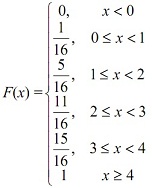Reference no: EM131306780
Midterm Exam
Instruction: By default, the graduate students are required to answer all the question below.
Question 1 part a) and Question 5 are not required for undergraduate students but are bonus problem for undergraduate students
Question 1. Write both the expanded form and matrix form of
a) σij = Cijklεkl with σij = σji (stress),εkl = εlk(strain),Cijkl = Cklij (Stiffness tensor)
(hint: for Cijkl it has 81 components,
σij = σji (this symmetry will reduce from 81 to 54),
εkl = εkl (this symmetry will further reduce from 54 to 36), )
Cijkl = Cklij (this symmetry will further reduce from 54 to 21)
Question 2. a) is not required for undergraduate students but is a bonus problem for undergraduates.
b) Tij.Sij
where (i, j, k, l = 1, 2, 3)
2. In the Cartesian coordinate, the stress-strain relationship can be given as below for isotropic and linear elastic materials, please use the Einstein summation index notation to rewrite the long form of the following equations into one compact form equation.
ε11 = 1/E[σ11 - v(σ22 + σ33), ε12 = (1+v)/E.σ12
ε22 = 1/E[σ22 - v(σ11 + σ33), ε23 = (1+v)/E.σ23
ε33 = 1/E[σ33 - v(σ11 + σ22), ε31 = (1+v)/E.σ31
Question 3. Write the components of b = T.S.a (or b =(TS)a ) in both index notation and matrix form, where a and b are vectors, T and S are 2nd order tensors.
Question 4. Prove that
(a) u x(v x w) = (u.w)v - (u.v)w
(b) u.(v x w) = w.(v x v) = v.(w x u)
(c) δijδjkδki = 3
where u, v, and w are vectors, "." and "x" are scalar products (or inner products or dot products) and cross product, respectively. δij is the Kronecker Delta function.
Is u x(v x w ) equal to (u x v )x w, why?
Question 5. (graduate students only) In the Cartesian coordinates, prove the vector identity
∇x(∇x u) = ∇(∇.u) - ∇2u
Question 6. Three motions are applied to a material in the following sequence
(a) A translational rigid motion moving origin C0 to C by uXC and uYC respectively. There is no motion along Z
(b) Then stretching of
λ1 = L/Lo, λ2 = Hz/HYo and uYC along X and Y, and Z, respectively
(c) rigid rotation ψ (positive counter clockwise CCW) in the X , Y , and Z, respectively
Questions:
1) Write the combined motion in the matrix form
2) Write the deformation and displacement gradients in the matrix form
3) Change the sequence of (a)→(b)→ (c) to
i) (a)→ (c)→ (b), i.e. translation-rotation-stretching
ii) (c)→(b)→(a), i.e. rotation-stretching-translation
Then, solve the corresponding questions in 1) and 2) and see if there is any difference.
